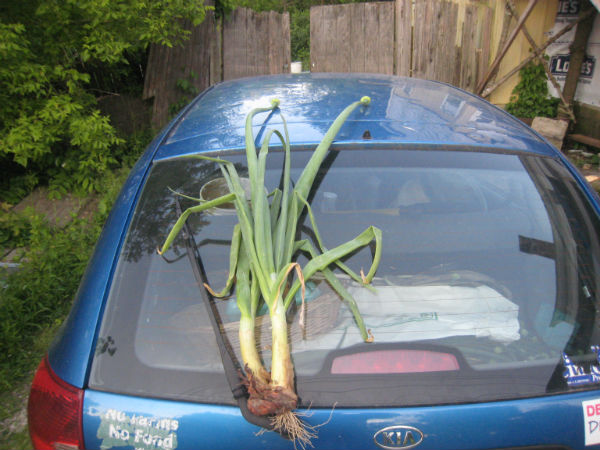About three weeks ago, I attended meetings of the layer and broiler/turkey subcommittees of Ohio’s Humane Livestock Care Standards Board. I’d meant to do a full write-up on the experience at the time, but here are the high points:
– If you’re looking for a get-rich-quick scheme and aren’t troubled by cruelty to animals, buy a little patch of land and build a caged layer operation NOW. It doesn’t have to be huge–just big enough to require a permit, which I think is anything over 500 birds–and it doesn’t even have to turn a profit. Just get it set up and get permitted so you’re an “existing farm” using cages by the time they implement the standards.
See, after the standards are implemented, nobody will be allowed to open a new caged-layer business…unless they already have one. “Existing farms” are getting grandfathered in. Not only will they be allowed to continue using cages, but there is no limit on future expansions of their operations. And–here’s the profitable part–they can transfer this right.
This means that if someone in Columbus wants to keep a couple chickens in a cage (per the Columbus Health Department’s requirements for keeping chickens in the city), they’ll be deemed to be treating their animals inhumanely after the implementation of these standards. But if someone has a half-acre somewhere with 500 laying hens stuffed into cages BEFORE the implementation of these standards, with each bird having only 67 square inches, they’re fine. Not only won’t they be in violation, but they can then sell their operation–and with it, the right to use cages–to the highest bidder, who, once having secured permission to use cages, can then go build million-bird caged layer egg factories in every county in Ohio if they want to.
Given that Ohio is presently the second or third largest egg-producing state in America, there must be some advantage to producing them here rather than elsewhere. And given that something like 98% of the eggs produced in Ohio come from caged layers, and that the Ohio Poultry Association and other representatives of the caged hen industry are fighting tooth and nail to maintain their right to use cages, it must be pretty valuable to them. For someone looking to start a new egg factory, what do you think a license to build one would be worth?
Or to put in another way, in the terms of a business we’re already used to thinking of as illicit: imagine if a handful of people in Ohio had a license to sell street drugs. Selling drugs would still be illegal and the police would still arrest people who did it…except for this handful of people who have a license. The license holders would be left alone. And no new licenses would ever be issued. And the license holders could sell their licenses or pass them on to their children. And there’s no limit to how much a license holder can expand his business. That’s what they’re talking about doing with eggs from caged layers. They’re not outlawing stuffing hens into little shoebox-sized cages; they’re just outlawing new competition against people who do. They’re giving the already-operating animal abusers a monopoly over their industry in Ohio.
This was the fundamental reason the Livestock Care Standards Board was created, and why Big Ag was pushing for it. They wanted to write their own rules, they wanted immunity from humane treatment requirements, and they wanted a huge giveaway from the government–in this case, exclusive rights to practice their business.
– On the bright side, the layer subcommittee removed most of the language that would have penalized egg producers for not using cages. Nobody seemed openly hostile to free-range poultry farmers, and the subcommittee members I spoke with all seemed genuinely concerned with making sure the needs of everyone from factory farms to backyard hobbyists were met as they attempted to create one-size-fits-all regulations that treat everyone fairly. They seemed sincerely open and receptive to hearing the concerns of the public and considering alternatives we suggested.
– The broiler/turkey subcommittee was very much an “old boys club.” I heard not one word of deliberation over whether any practices were humane or not, and there was pretty much a consensus on the idea that they didn’t need to bother responding to the concerns of the general public. The prevailing question determining whether a practice would be allowed or not was, “Does anybody here do this? Do you know anybody who does this?”
It was quite a trip down the rabbit hole. One of the rules they discussed was a requirement that pens be kept clean. It’s common practice in large broiler operations for them to dry out, roto-till, or compost soiled bedding and re-use it. They’d never dream of actually cleaning out pens every week and replacing the manure with newly purchased bedding. They just try to eliminate the pathogens, pump the birds full of antibiotics, and keep using the same bedding full of manure over and over again. This, by industry standards, is “clean.” (And now you know why you can get chicken legs for 99 cents a pound or less in the grocery store) One farmer expressed concern over this requirement to keep the pens clean. He said, “I know my houses are clean and you know they’re clean, but the 4th grade teacher bringing a class full of kids might not think they’re clean.” He was concerned that such a visitor might file a complaint.
The rest of the group reassured him. “That 4th grade teacher isn’t the one you need to satisfy that it’s clean. It’s Dr. (whomever the inspector at the ODA is) who will be looking at it, and he knows what ‘clean’ means in a poultry operation.”



